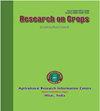通过冷痕化和基于辣木的生物刺激剂对黄花蒿萌芽进行种子处理
Q3 Agricultural and Biological Sciences
引用次数: 0
摘要
在不同的文化传统中,黄花蒿是一种常用的药用植物,可用于治疗各种健康问题。尽管其自然栖息地很好,但对其进行系统栽培的努力却很有限,因此有关其种子生物学和发芽特性的文献资料很少。本研究旨在确定不同温度、去痕、光照条件和生物刺激剂对黄花蒿种子萌发的影响。对种子进行了不同的去痕处理,包括摩擦(砂纸)、冷热水浸泡、酸(H2SO4)和发酵(EM),并与未经处理的种子(对照)进行了比较。光照周期包括恒定光照、交替光照(16/8 小时)和连续黑暗,温度分别为 15 °C、25 °C 和 35 °C。结果表明,25 °C的温度明显提高了发芽率,而在15 °C和35 °C的温度下没有发芽。热水和冷水灼烧可提高发芽率。在所有实验中都没有观察到发酵种子的萌发。在光周期方面,交替光照下的发芽率最高,达到 70%。在 25 °C 的交替光照条件下使用基于辣木的生物刺激剂可提高 MGT。这项研究产生的信息将有助于弥合科学差距,为通过种子繁殖 A. afra 提供最佳要求方面的信息。本文章由计算机程序翻译,如有差异,请以英文原文为准。
Seed priming by cold scarification and Moringa-based bio-stimulant on the germination of Artemisia afra
Artemisia afra is a frequently utilized medicinal plant in diverse cultural traditions for the management of various health conditions. Despite its natural habitat, limited efforts have been dedicated to its systematic cultivation, resulting in a paucity of documented information concerning its seed biology and germination characteristics. This study aimed to determine the effect of different temperatures, scarification, light conditions and priming with biostimulant on the seed germination of Artemisia afra. The seeds were exposed to different scarification methods including rubbing (sandpaper), hot and cold-water soaking, acid (H2SO4) and fermentation (EM) and compared with untreated seeds (control). Photoperiods included constant light, alternating light (16/8 hours) and continuous darkness at 15 °C, 25 °C and 35 °C. Results revealed that 25 °C temperature significantly improved germination while no germination was obtained at 15°C and 35°C. Hot and cold-water scarification resulted in improved germination. There was no germination observed for fermented seeds in all the experiments. In photoperiod, the highest germination percentage of 70 % was observed under alternating light. Using Moringa based biostimulant under alternating light conditions at 25 °C resulted in improved MGT. The information generated from this study will contribute to bridging the scientific gap by generating information on optimum requirements for propagating A. afra through seeds.
求助全文
通过发布文献求助,成功后即可免费获取论文全文。
去求助
来源期刊

Research on Crops
Agricultural and Biological Sciences-Soil Science
CiteScore
1.50
自引率
0.00%
发文量
93
审稿时长
1 months
期刊介绍:
The Research on Crops is a peer-reviewed journal publishing original research papers, review articles and short communications in English on all basic and applied aspects of crop sciences, agricultural water management, agro-climatology, agroforestry, agronomy, crop production, crop protection, cropping systems, food science & technology, genetics & plant breeding, horticulture, plant & soil science, plant biotechnology, plant nutrition, post-harvest management of crops, seed science, soil management & tillage, vegetables, weed science, agricultural engineering, agri-business, agricultural economics and extension, etc. The aim of the journal is to provide a forum for the scientific community to publish their latest research findings.
The manuscripts submitted for publication should not contain data older than 4 years on the date of submission.
The articles submitted for publication in this journal should not be submitted elsewhere simultaneously for publication in another journal. These should not carry any copyright material without prior permission of copyright holder.
The articles should present a complete picture of the investigation made and should not be split into parts.
There is no prescribed limit regarding the number of pages in case of full-length articles. However, the authors are advised to keep the length of their articles from 4 to 10 full printed pages of the journal.
The articles should be divided into the sub-sections: ABSTRACT, INTRODUCTION, MATERIALS AND METHODS, RESULTS AND DISCUSSION, CONCLUSIONS, and REFERENCES. Tables and figures should be appended separately at the end.
 求助内容:
求助内容: 应助结果提醒方式:
应助结果提醒方式:


